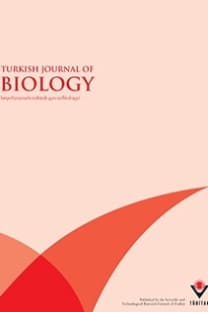Enhancing the expression of Aspergillus niger Ã-mannanase in Pichia pastoris by coexpression of protein disulfide isomerase
Aspergillus niger, Ã-mannanase, Pichia pastoris, protein disulfide isomerase, expression condition optimization
Enhancing the expression of Aspergillus niger Ã-mannanase in Pichia pastoris by coexpression of protein disulfide isomerase
Aspergillus niger, Ã-mannanase, Pichia pastoris, protein disulfide isomerase, expression condition optimization,
___
- Cereghino GPL, Cereghino JL, Ilgen C, Cregg JM (2002). Production of recombinant proteins in fermenter cultures of the yeast Pichia pastoris. Curr Opin Biotechnol 13: 329–332.
- Cereghino JL, Cregg JM (2000). Heterologous expression system in the methylotrophic yeast Pichia pastoris. FEMS Microbiol Rev 24: 45–66.
- Chen X, Qiao J, Yu H, Cao Y (2009). Overexpression of an optimized Aspergillus sulphureus β-mannanase gene in Pichia pastoris. Biologia 64: 235–238.
- Chen XL, Cao YH, Ding YH, Lu WQ, Li DF (2007). Cloning, functional expression and characterization of Aspergillus sulphureus β-mannanase in Pichia pastoris. J Biotechnol 128: 452–461.
- Chen XL, Huang ZQ, Zhou B, Wang H, Jia G, Qiao JY (2014). Expression and purification of porcine Akirin2 in Escherichia coli. Turk J Biol 38: 339–345.
- Gilbert HF (1998). Protein disulfide isomerase. Methods Enzymol 290: 26–50.
- Heidorne FO, Magalhães PO, Ferraz AL, Milagres AMF (2006). Characterization of hemicellulases and cellulases produced by Ceriporiopsis subvermispora grown on wood under biopulping conditions. Enzyme Microb Technol 38: 436–442.
- Hohenblum H (2004). Effects of gene dosage, promoters, and substrates on unfolded protein stress of recombinant Pichia pastoris. Biotechnol Bioeng 85: 367–375.
- Inan M, Aryasomayajula D, Sinha J, Meagher MM (2006). Enhancement of protein secretion in Pichia pastoris by overexpression of protein disulfide isomerase. Biotechnol Bioeng 93: 771–778.
- Morreira LR, Filho EX (2008). An overview of mannan structure and mannan-degrading enzyme systems. Appl Microbiol Biotechnol 79: 165–178.
- Ngiam C, Jeenes DJ, Punt PJ, Van Den Hondel CA, Archer DB (2000). Characterization of a foldase, protein disulfide isomerase A, in the protein secretory pathway of Aspergillus niger. Appl Environ Microbiol 66: 775–782.
- Noiva R (1999). Protein disulfide isomerase: the multifunctional redox chaperone of the endoplasmic reticulum. Semin Cell Dev Biol 10: 481–493.
- Powers SL, Robinson AS (2007). PDI improves secretion of redox- inactive beta-glucosidase. Biotechnol Prog 23: 364–369.
- Roth R, Moodley V, Zyl P (2009). Heterologous expression and optimized production of an Aspergillus aculeatus endo-1,4- β-mannanase in Yarrowia lipolytica. Mol Biotechnol 43: 112– 120.
- Sha C, Yu X, Lin N, Zhang M, Xu Y (2013). Enhancement of lipase r27RCL production in Pichia pastoris by regulating gene dosage and co-expression with chaperone protein disulfide isomerase. Enzyme Microb Tech 53: 438–443.
- Shen Q, Wu M, Wang H, Naranmandura H, Chen S (2012). The effect of gene copy number and co-expression of chaperone on production of albumin fusion proteins in Pichia pastoris. Appl Microbiol Biotechnol 96: 763–772.
- Smith JD, Tang BC, Robinson AS (2004). Protein disulfide isomerase, but not binding protein, overexpression enhances secretion of a non-disulfide-bonded protein in yeast. Biotechnol Bioeng 85: 340–350.
- Sitia R, Braakman I (2003). Quality control in the endoplasmic reticulum protein factory. Nature 426: 891–894.
- Tang CD, Guo J, Li JF, Wei XH, Hu D, Gao SJ, Yin X, Wu MC (2014). Enhancing expression level of an acidophilic β-mannanase in Pichia pastoris by double vector system. Ann Microbiol 64: 561–569.
- Tsai CW, Duggan PF, Shimp RL Jr, Miller LH, Narum DL (2006). Overproduction of Pichia pastoris or Plasmodium falciparum protein disulfide isomerase affects expression, folding and O-linked glycosylation of a malaria vaccine candidate expressed in P. pastoris. J Biotechnol 121: 458–470.
- Wang H, Chen XL, Huang ZQ, Zhou B, Jia G, Liu GM, Zhao H (2014). Expression and purification of porcine PID1 gene in Escherichia coli. Turk J Biol 38: 523–527.
- Wu D, Yu XW, Wang TC, Wang R, Xu Y (2011). High yield Rhizopus chinenisis prolipase production in Pichia pastoris: impact of methanol concentration. Biotechnol Bioprocess Eng 16: 305–311.
- Wu MC, Tang CD, Li JF, Zhang HM, Guo J (2011). Bimutation breeding of Aspergillus niger strain for enhancing β-mannanase production by solid-state fermentation. Carbohydr Res 346: 2149–2155.
- Zhang J, Wu D, Chen J, Wu J (2011). Enhancing functional expression of β-glucosidase in Pichia pastoris by co-expression protein disulfide isomerase. Biotechnol Bioprocess Eng 16: 1196–1200.
- ISSN: 1300-0152
- Yayın Aralığı: 6
- Yayıncı: TÜBİTAK
Arulvilee RAJASEGAR, Asyraf MANSOR, Ranjetta POOBATHY, Elayabalan SIVALINGAM, Uma Rani SINNIAH, SREERAMANAN SUBRAMANIAM
Td-DAMD-PCR assays for fngerprinting of commercial carnations
Abdurasul YARBEKOV, Mavluda ZAKHIDOVA, Vakhobjon KUVONDIKOV, Erkin NORMATOV, Aziz SAPARBAYEV, Erkin ZAKHIDOV, Abdumutallib KOKHKHAROV, Sherzod NEMATOV
Biological impact of feeding rats with a genetically modifed-based diet
Hanaa ORABY, Mahrousa KANDIL, Nermeen SHAFFIE, Inas GHALY
KALAMEGAM KALAIARASI, GOVINDARAJ PRASANNARAJ, SHIVENDRA VIKRAM SAHI, PERUMAL VENKATACHALAM
ERUM SHOEB, NUZHAT AHMED, JAMEELA AKHTER, UZMA BADAR, KHAIZRAN SIDDIQUI, FAIZA ANSARI, MAHEEN WAQAR, SAMINA IMTIAZ, NIMRAH AKHTAR, QURAT UL AIN SHAIKH, ROANUQ BAIG, SABA BUTT, SAEMA KHAN, SIDRA KHAN, SHAHID HUSSAIN, BASHIR AHMED, MAQSOOD A. ANSARI
Biological impact of feeding rats with a genetically modified-based diet
HANAA ORABY, MAHROUSA KANDIL, NERMEEN SHAFFIE, INAS GHALY
Micropropagation of Vaccinium myrtillus L. (Bilberry) naturally growing in the Turkish fora
BO ZHOU, XIAOLING CHEN, ZHIQING HUANG, GANG JIA, GUANGMANG LIU
